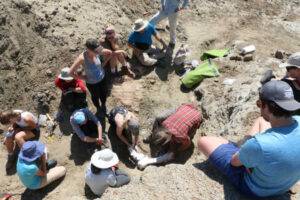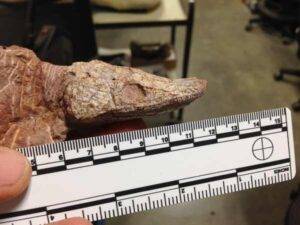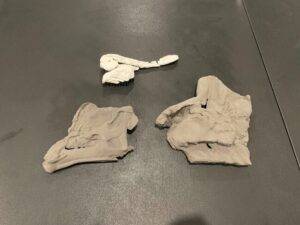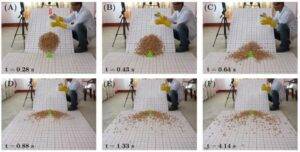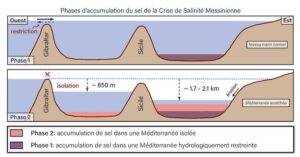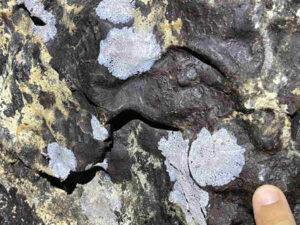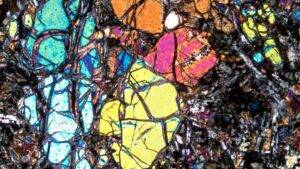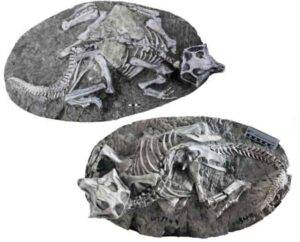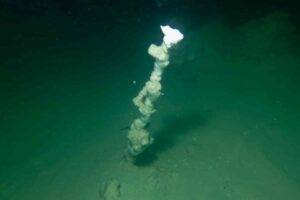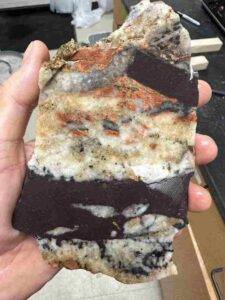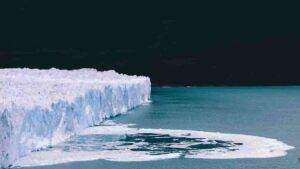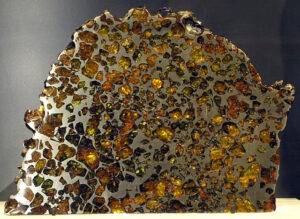
The pterosaurs are extinct flying reptiles that lived alongside their close relatives, the dinosaurs. The largest of these reached 10 m in wingspan, but early forms were generally limited to around 2 m. In a new paper today, a team led by palaeontologist Dr David Hone of Queen Mary University of London and published in the journal Current Biology describes a new species of pterosaur that helps to explain this important transition.
They named the animal Skiphosoura bavarica meaning ‘sword tail from Bavaria’ because it comes from southern Germany and has a very unusual short, but stiff and pointed tail. The specimen is complete with nearly every single bone preserved and unusually, it is preserved in three dimensions, where most pterosaurs tend to be crushed flat. In life it would have been about 2 m in wingspan, similar to that of large birds like the golden eagle.
For two hundred years, palaeontologists split the pterosaurs into two major groups, the early non-pterodactyloids and the later and much larger pterodactyloids. The early pterosaurs had short heads on short necks, a short bone in the wrist of the wing, a long 5th toe on the foot and long tails, and the pterodactyloids had the opposite: large heads on long necks, a long wrist, short 5th toe and short tail. But which parts of their body changed when between these groups was not known.
In the 2010s, a series of intermediate species called darwinopterans were found that revealed that the head and neck had changed first before the rest of the body. It was a great example of an intermediate that bridged an evolutionary gap. But it also meant we did not really know what was going on before or after these changes.
Skiphosoura reveals these changes. Evolutionarily it sits between these earlier darwinopterans and the pterodactyloids. It retains a very pterodactyloid-like head and neck, but also shows a longer wrist, and a shorter toe and tail than earlier darwinopterans but these are not as extreme as those seen in the pterodactyloids. With the study also comes a new reconstruction of the evolutionary family tree for pterosaurs. In addition to showing the intermediate position of Skiphosoura, it also shows that a Scottish pterosaur, Dearc, as fitting in the mirror position between the early pterosaurs and the first darwinopterans.
In other words, we now have a complete sequence of evolution from early pterosaurs to Dearc, to the first darwinopterans to Skiphosoura, to the pterodactyloids. While not every specimen is complete, we can now trace the increase in size of the head and neck, the elongating wrist, shrinking toe and tail and other features step-by-step across multiple groups. It’s a superb illustration of the evolution of a group for which the transition has been far from clear before.
Both Dearc and Skiphosoura are unusually large for their time also suggesting that the changes that enabled the pterodactlyoids to reach enormous sizes were appearing even in these transitional species.
Dr David Hone, from Queen Mary University of London, said: “This is an incredible find. It really helps us piece together how these amazing flying animals lived and evolved. Hopefully this study will be the basis for more work in the future on this important evolutionary transition”.
Adam Fitch, from the University of Wisconsin-Maddison, said: “Pterosaurs have long been symbols of the unique life of the past. Skiphosoura represents an important new form for working out pterosaur evolutionary relationships and by extension how this lineage arose and changed.”
René Lauer of the Lauer Foundation said: “The specimen was disarticulated with bones of varying quality often overlaid upon one another. Digital photography of the specimen taken in both visible and UV light significantly aided in the process to identify these elements and to better analyze finer details that were not discernible in normal daylight alone” and Bruce Lauer of the Lauer Foundation said: “The Lauer Foundation is proud to have the opportunity to bring this important specimen to science and further the understanding of pterosaur evolution”.
Stefan Selzer an author on the project who prepared the specimen said: “As a preparator I have worked on more than 60 pterosaur specimens from Solnhofen limestone. I recognized during the final prep this specimen showed features that combined characteristics of both major groups of pterosaurs, with the shortened tail as the most important diagnostic feature.”
Reference:
David William Elliott Hone, Adam Fitch, Stefan Selzer, René Lauer, Bruce Lauer. A new and large monofenestratan reveals the evolutionary transition to the pterodactyloid pterosaurs. Current Biology, 2024; DOI: 10.1016/j.cub.2024.10.023
Note: The above post is reprinted from materials provided by Queen Mary University of London.


